
views
Choosing a Liquid Cleaning Solution
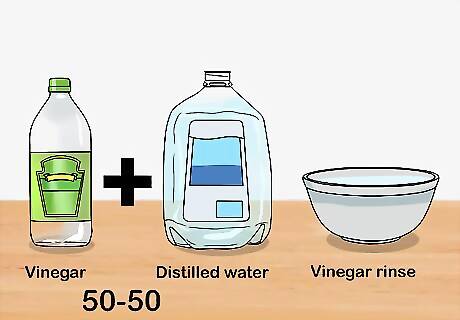
Use a vinegar rinse. Create a 50-50 distilled water and white vinegar mixture in a bowl. If you are just doing a light clean, lower the amount of vinegar. Apple cider vinegar can be a substitute as well, just as long as you aren’t interested in sanitizing the leather. Wipe the solution over your leather until it is damp. Make sure to mix the vinegar with water, as straight vinegar can be too acidic for leather.
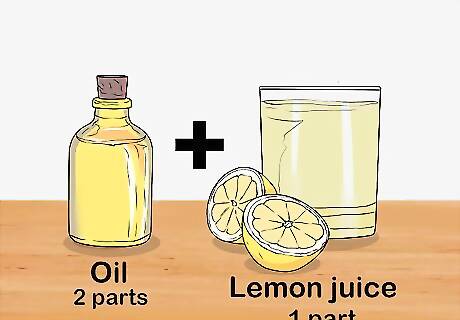
Wipe down with a natural oil. Get a bowl and mix together two parts oil with one part water or lemon juice. Any natural oil will work fine and many people like the smell of coconut, olive, or even walnut. The oil will help to hydrate your leather, while the lemon will remove any dirt or grime. Apply the mixture to your leather until it is damp and then buff it with a microfiber cloth. If you are just interested in polishing your leather, then you can apply the oil directly to the leather. Make sure to keep the coating light or you could stain it.
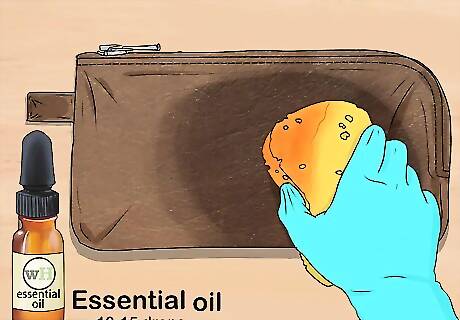
Massage with essential oils. Place 10-15 drops of essential oil onto a microfiber cloth or sponge. Moving in small circles, gently work the oil into your leather. Leave no excess on the surface and continue until you cover all visible areas. Make sure to select an oil scent that you enjoy, such as lemon or lavender.
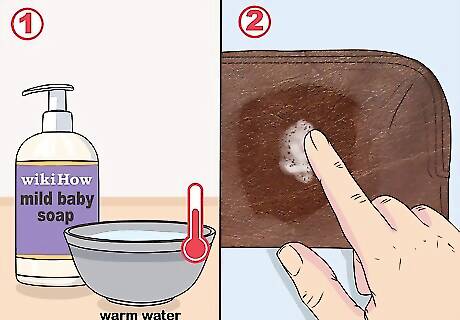
Apply mild baby soap or detergent. Get one quart of warm water and add in a few drops of baby soap or natural detergent. Add a few drops of vinegar as well, if the leather is particularly dirty. Use this as a leather conditioner, as it will both clean leather products and help to prevent new stains. After applying this over the leather’s surface, feel free to let it air dry. With all of these applications, it is best to use distilled water, as this will prevent you from adding particle residue to the leather’s surface.
Choosing a Solid Cleaning Solution
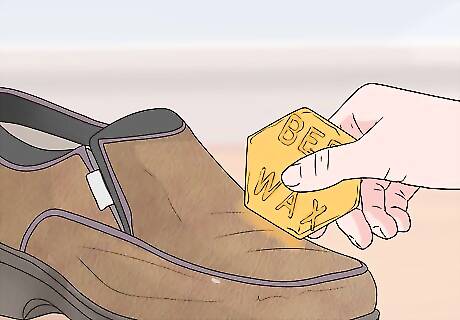
Condition with beeswax. Purchase general use beeswax or beeswax used specifically for leather goods, which is usually available in most clothing stores. Carefully heat up the beeswax in a saucepan until it is warm, but not liquefied. Add any scents that you prefer, such as almond oil. Place this balm onto a microfiber cloth and massage it into the surface of the leather. Get a fresh cloth and wipe away any excess.
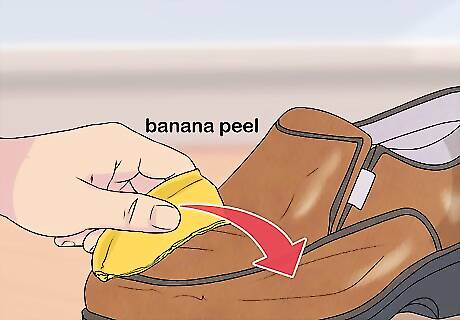
Buff with a banana. Get a fresh banana peel. Place the inside of the peel onto the surface of the leather. Move the peel around, so that the natural oils inside fully cover the leather. You may need more than one peel, depending on the amount of surface that you need to clean. The oils of the peel will attract dirt away from the surface, leaving the leather looking and smelling clean. If you notice any peel residue on the leather, then get a fresh cloth and wipe it across the surface.

Make a cream of tartar paste. In a bowl, add together one part cream of tartar and one part lemon juice. Stir them together until they form a paste. Place the paste directly on top of any stains or problem areas. Wait a few minutes and then wipe the paste away with a damp cloth. Repeat as necessary.
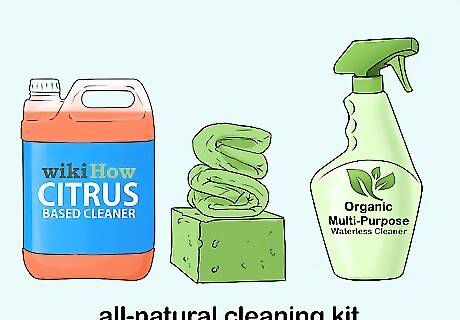
Buy an all-natural cleaning kit. You can get a kit of this type at a clothing store or online. It will generally contain a cleaning solution, a cloth, and a direction sheet. Make sure to follow any enclosed directions very closely. Read the ingredients list closely as well, if you are concerned about only using natural products.
Applying the Solution
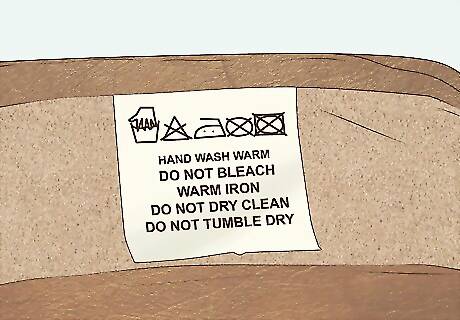
Consult the manufacturer’s instructions, if available. If your leather product has a label, read it carefully before following any cleaning routine. In the case of clothing, the label will tell you whether or not the item is machine washable. For furniture, the label may direct you to a customer service contact for more information. You may have also received paper instructions after purchase. If you don’t have a label to consult, but you know the manufacturer’s name, then you can visit their website. If they have a website, they will likely list a customer helpline or support center.
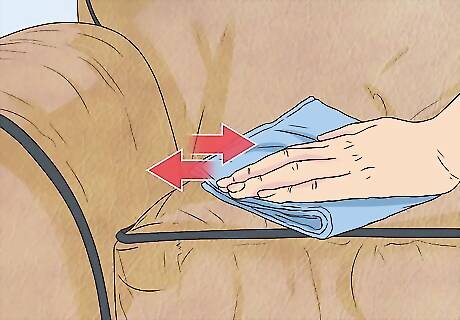
Wipe off any dirt beforehand. Get a dry microfiber cloth and go over the surface of the leather. This will help you to remove any dust and surface debris. In the case of furniture, run a vacuum brush attachment over the surface. Doing this step before every cleaning will prevent you from working dirt deeper into the leather, which could give it a gritty appearance.
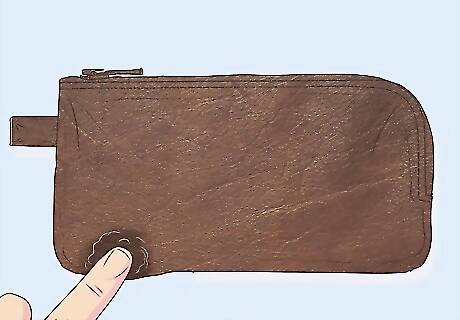
Do a test spot. Before you apply any cleaning solution, find a spot that is small and out-of-the-way and use it to test the cleaner. Place a small amount of the solution on the area and wait a few minutes. Wipe it off and then look for any discoloration or wrinkling. If you notice damage to the leather, then you may need to talk with a cleaning professional, such as dry cleaner for clothes, before proceeding.
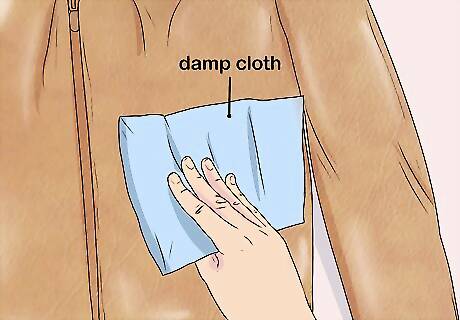
Dampen the leather. Excessive moisture on leather can cause it to wrinkle and fade. When you apply a cleaning solution or balm to any leather product, make sure to wipe away any excess immediately. Always use a damp towel or cloth, not a soaked one, as this will allow you to control the moisture applied to the leather.

Wipe with the grain. Look over the surface of the leather and see if you can discern any pattern. If the grain of the leather heads in one direction, apply any balm in line with this pattern. This will let the moisture of the cleaner go into the grooves of the leather to remove any dirt or debris found in those pockets.
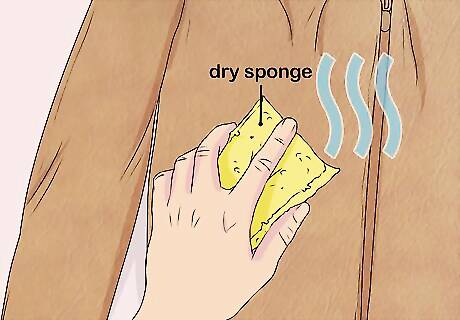
Dry it off. As the finishing touch, get a dry sponge or microfiber cloth and go over the leather a final time. Look to see if there are any stains that need additional treatment. Removing any cleaning residue will help to prevent dust from sticking to the surface.




















Comments
0 comment